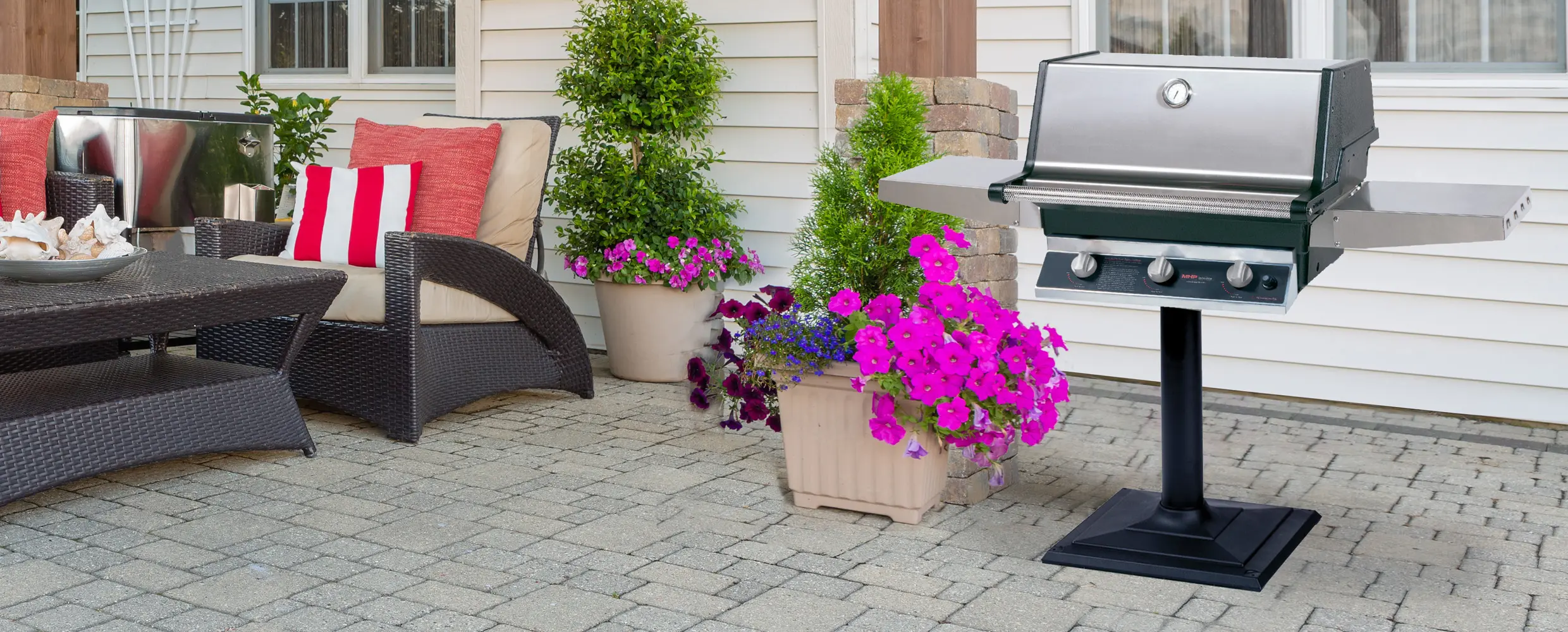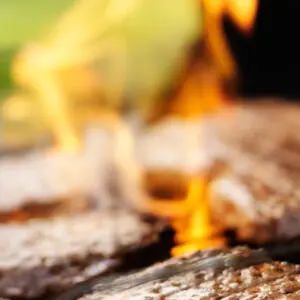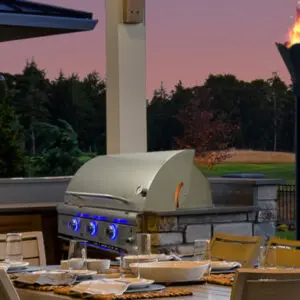
Post or patio-mount gas grills are designed to be mounted on a post or attached to a patio or deck utilizing a base that has been secured with bolts. These grills are a popular choice for those who have limited space or want to create a permanent grilling station in their outdoor entertainment area.
Here are some key features and considerations for post/patio mount gas grills.
Permanent Installation: These grills are designed for permanent installation. They are typically secured to a stable post in the ground or attached to a patio or deck base with bolts. This ensures stability and safety during use.
Space Efficiency: Post or patio-mount gas grills are a smart choice for smaller outdoor spaces where a freestanding grill might not fit. They help maximize the use of limited outdoor areas.
Fuel Type: Post/patio-mount grills can run on propane or natural gas. Choose a grill that matches your preferred fuel source and has the necessary connections readily available.
Additional Features: Consider any extra features that enhance your grilling experience, such as burner options, side burners, warming racks, and rotisserie kits. These features can add versatility to your outdoor grilling.
Accessories: Our grills typically feature side shelves with utensil hooks incorporated into the design, offering additional preparation space while keeping grilling utensils organized and easily accessible. Additionally, you may consider using a grill cover to protect your grill from the elements, including rain, snow, and UV rays, which can extend the grill’s lifespan, reduce maintenance, and keep it looking good.
Safety: Always follow safety guidelines and local regulations when installing and using your post/patio-mount gas grill, especially when dealing with gas connections. Ensure proper ventilation and clearances from combustible materials.
Budget: Establish a budget for your grill purchase and stick to it. Grills are available at various price points, so you can find one that suits your budget while meeting your needs.
Maintenance: Regular cleaning and maintenance are essential to keep your grill in top working condition. Cleaning the grates, burners, and grease trays, as well as checking for gas leaks, should be part of your routine.
GAS TYPE
Pos-Mount/Patio-Mount grills are available for both natural and propane gas applications.
 Propane (LP) Gas
Propane (LP) Gas
Propane grills are often used with portable propane cylinders. The tanks are connected to the grill using hoses and regulators. When the tank is empty, it can be replaced with a full one. Ideal for those without a natural gas hookup.
Pros
- Convenience: LP gas is readily available at many stores and gas stations, making it easy to find and refill your propane tank. You don’t need to worry about lighting briquettes, as you can simply turn on the gas and start grilling.
- Quick Start: Propane grills ignite quickly, allowing you to start grilling almost immediately. This is especially useful for those impromptu grilling sessions.
- Temperature Control: Propane grills offer precise temperature control. Adjustable burners that let you regulate the heat easily, making it simple to grill various types of food.
- Clean Burning: Propane is a clean-burning fuel, producing fewer emissions and less smoke. This can lead to a more enjoyable grilling experience, especially in terms of reduced smoke exposure.
- Even Cooking: Propane grills often distribute heat more evenly across the cooking surface, leading to more consistent grilling results.
Cons
- Dependency on Fuel: Using propane requires a continuous supply of fuel, and you may need to keep spare propane tanks on hand in case you run out while cooking.
- Cost: Propane can be more expensive compared to other fuel sources on a per-grill basis. While it’s efficient in terms of energy, the cost of propane can accumulate over time, especially if you grill frequently.
- Portability: While propane grills are relatively portable, they still require a propane tank to operate, which can be bulky and heavy to transport, especially for camping or picnics.
 Natural Gas
Natural Gas
Grilling with natural gas offers the advantages of convenience, cost-efficiency, and consistent heat, along with environmental benefits. However, it comes with drawbacks like installation complexity and limited portability.
Pros
- Convenience: Natural gas grills are typically connected to a fixed natural gas line, providing a continuous and readily available fuel source. This eliminates the need to refill propane tanks.
- Cost-Efficiency: Natural gas is often cheaper than propane on a per-unit energy basis. If you have a natural gas line at your home, grilling with natural gas can be more cost-effective in the long run.
- Consistent Heat: Natural gas grills provide consistent and even heat distribution. This can result in better grilling results, as you have more control over temperature and can avoid hot spots.
- Environmental Impact: Natural gas burns cleaner than some other fuels, producing fewer pollutants and emissions. It is considered a more environmentally-friendly option.
- No Refills Needed: Since natural gas grills are directly connected to a gas line, you don’t need to worry about running out of fuel in the middle of grilling.
- Quick Ignition: Natural gas grills usually have instant ignition systems, making them easy to start and reducing the waiting time before you can start grilling.
Cons
- Installation Complexity: Setting up a natural gas grill requires a fixed natural gas line, which might not be readily available in all homes. Installation can be more complex and expensive, involving the services of a professional plumber or gas fitter.
- Location Restrictions: Natural gas grills are not as portable. They are fixed in place due to the gas line connection. You can’t move the grill around your yard or take it with you for outdoor events.
- Initial Cost: Natural gas grills tend to be more expensive upfront compared to some other grills. The cost includes the grill itself and potential installation fees.
- Dependency on Gas Line: If there’s a gas line issue or outage, you won’t be able to use the grill until the problem is resolved. This can be a limitation if you rely solely on natural gas for grilling.
GRILL SIZE
A big consideration when deciding on a grill is size.
Size is a crucial factor to consider when choosing a grill. It’s important to balance your current needs with potential future ones. Here are some points to keep in mind:
Regular vs. Occasional Usage: Consider how often you’ll be using the grill and for how many people. If you typically grill for a small family, but occasionally have larger gatherings, it might make sense to opt for a larger grill to accommodate those special occasions.
Flexibility for Growth: If you anticipate your gatherings growing in size, it’s a good idea to “size up” and choose a larger grill. This way, you won’t be limited in the future when you want to grill for a larger group.
Burner Count and Cooking Techniques: The number of burners is often correlated with the size of the grill. More burners allow for better temperature control and the ability to use various cooking techniques like indirect grilling. Larger grills typically offer more versatility in this regard.
Primary Grilling Surface: The main cooking area, measured in square inches, should be your primary consideration. This is where the majority of your cooking will take place. Make sure it’s large enough to accommodate the amount of food you’ll be grilling regularly.
Secondary Work Surfaces: Don’t forget about secondary areas like warming racks and side burners. These can provide extra space for keeping cooked food warm or preparing side dishes, sauces, and more.
Accessories and Storage: Larger grills often come with additional features like side tables, storage cabinets, and hooks for utensils. These can greatly enhance your grilling experience by providing convenient workspaces and storage solutions.
Space Consideration: While thinking about grill size, also consider where you’ll place it. Make sure you have enough space in your outdoor area for the grill you’re considering.
Budget: Larger grills with more features tend to be more expensive. Balance your budget with your requirements to find the best fit.
Small

Grill Head:
Up to 26″
Primary Grilling Surface:
400-495 Sq. In
Burger Count:
Up to 15 burgers
Recommended for:
3-6 people
These grills are well-suited to small cookouts and are ideal if you don’t have a lot of space in your outdoor entertainment area
Mid-Sized

Grill Head:
27″-33″
Primary Grilling Surface:
525-642 Sq. In
Burger Count:
Up to 23 burgers
Recommended for:
6-9 people
This is the most popular and often the ideal size for most grillers.
Large

Grill Head:
34″-42″
Primary Grilling Surface:
642-928 Sq. In
Burger Count:
Up to 33 burgers
Recommended for:
6-9 people
This is the most popular and often the ideal size for most grillers.
X-Large

Grill Head:
43″+”
Primary Grilling Surface:
714-966 Sq. In
Burger Count:
Up to 45 burgers
Recommended for:
9+ people
These big grills are usually for serious grillers or entertainers—offering the largest cooking area and a higher number of burners.
GRILL MATERIALS
A built-in gas grill is a long-term investment so buying a grill that will stand up to the elements is an important consideration. Regardless of which material you choose, regular maintenance will go a long way.
Cast Aluminum
 Permanent mold heavy-duty cast aluminum housings have several advantages:
Permanent mold heavy-duty cast aluminum housings have several advantages:
- Heat Distribution: Cast aluminum grills are known for their excellent heat distribution. They can heat up quickly and evenly, which helps in grilling food consistently.
- Quick Preheating: The efficient heat conductivity of cast aluminum means that these grills preheat quickly, allowing you to start grilling sooner.
- Rust-resistant, durable, and long-lasting: Cast aluminum is a durable material that can withstand outdoor elements and resist rust and corrosion better than some other materials like steel. This makes the grill suitable for outdoor use.
- Lightweight: Cast aluminum is lighter than cast iron, which makes these grills more portable and easier to move around when needed.
- Longevity: A well-maintained cast aluminum grill can have a long lifespan, offering years of reliable use without significant deterioration.
- Low Maintenance: Cast aluminum grills generally require a low level of maintenance. Most impact damage can be repaired.
- Fuel Efficiency: Cast aluminum grills require less fuel to reach and maintain high cooking temperatures, making them relatively fuel-efficient compared to some other types of grills.
- Attractive—can add to the aesthetics of your outdoor space.
Stainless Steel

Stainless steel grill is popular among grill enthusiasts due to its numerous benefits, including:
Durability: Stainless steel is highly durable and resistant to rust, corrosion, and staining. This makes stainless steel grills suitable for outdoor use where they are exposed to various weather conditions.
Longevity: Due to its resistance to rust and corrosion, stainless steel grills tend to have a longer lifespan compared to grills made from other materials.
Easy Maintenance: Stainless steel is relatively easy to clean and maintain. It can be wiped down with a damp cloth to remove grease and food residue.
Aesthetic Appeal: Stainless steel grills have a sleek and modern appearance that many people find visually appealing. They can complement various outdoor design styles.
Heat Retention: Stainless steel retains heat well and distributes it evenly across the grilling surface. This can result in consistent grilling and better searing of food.
High Heat Capacity: Stainless steel can withstand high temperatures without warping or distorting. This makes it suitable for grilling techniques that require intense heat.
Hygienic: Stainless steel is non-porous and doesn’t harbor bacteria or other pathogens. This makes it a more sanitary option for grilling food.
Installations
With posts and bases we are talking about two types of installations—In-Ground or Patio/Deck
- Post mount Installations include the grill head installed onto a post which is permanently installed into the ground
- Patio/Deck Installations include a grill head installed onto a post which is then installed into a base that is bolted down to the patio or deck
In-Ground Installation
- Stability: Mounting a gas grill on a post anchored into the ground provides excellent stability and minimizes any wobbling or movement during use. This is especially important for larger and heavier grills.
- Permanent Setup: Installing on a post creates a more permanent grilling station, which can be advantageous if you want a dedicated outdoor cooking area.
- Space Utilization: Post-mounted grills can be ideal for smaller outdoor spaces where a freestanding grill might not fit, as they take up less floor space.
- Ventilation: Post installations may provide better airflow and ventilation around the grill, reducing the risk of gas buildup and improving safety.
- Aesthetics: A post mounted grill can add an attractive element to your outdoor space.
Considerations for In-Ground Installations:
- Installation may require more effort and expertise, including digging a hole for the post and ensuring proper gas connections.
- It may be less flexible if you decide to rearrange your outdoor space in the future.
- Depending on local regulations, you may need permits or approvals for this type of installation.
In-Ground Gas Grill Options
View all in-ground post-mount models >

MHP WNK
Patio/Deck Installatons
Versatility: A grill with a post and patio/deck base while bolted in place, can be moved and relocated as needed, making it a more flexible option if you plan to rearrange your outdoor space or take your grill with you when you move.
Ease of Installation: Setting up a grill with a base is typically less labor-intensive, when comparing in-ground installations, and may not require specialized installation expertise.
Temporary Use: If you don’t have a permanent outdoor grilling area or want the option to store your grill indoors during certain seasons, a base allows for easier disassembly and storage.
Adaptability: You can change the location of the grill within your outdoor space without the constraints of a fixed post.
Considerations for Patio/Deck Installations:
- Bolted bases may not provide the same level of stability as post installations, particularly for larger or heavier grills.
- Frequent movement or relocation may increase wear and tear on the grill and its components.
- You must ensure the bolts are properly secured to prevent any accidents or tipping of the grill.
Patio/Deck Gas Grill Options

MHP TJK
FEATURES
Carefully consider all features since this is a long-term investment. Make sure the grill will be able to accommodate the various types of grilling you want to do.
Lighting
For those who enjoy grilling after the sun sets, a remarkable feature to consider is a grill equipped with LED interior lights or backlit control knobs. Beyond their stylish appeal, these elements offer exceptional functionality. Integrated LED lights bring the grilling surface to life, ensuring you have clear visibility to cook with precision even in low-light conditions. Additionally, they illuminate the control panel, enabling you to effortlessly adjust settings, extending your grilling sessions well into the evening. Experience the perfect blend of aesthetics and practicality with a grill that transforms nighttime grilling.
Grilling (Heat) Zones
Grills can have one or more burners giving you the option to create different heat zones. Do you want nice sear marks on your steak or are you looking to grill up some nice ribs? These two items require different grill techniques to produce the best results. For sear marks, you will want to use direct heat while meats that require low and slow or more than 20 minutes to cook should be grilled using indirect heat. This is where the ability to create different heat zones comes into play.
Burner Options
Burners function as the cornerstone of a gas grill’s performance. Their capacity is typically measured in BTUs, and in general, a higher BTU rating is considered favorable. However, it’s crucial to understand that a grill’s cooking prowess isn’t solely contingent on having the highest BTUs. Numerous other factors, such as the grill’s cooking surface area and the distance between the burners and the food, also significantly influence its cooking performance.
So which one works best for you? We have outlined some of the pros for each burner option.
 Traditional Tube Burners
Traditional Tube Burners
- Ease of use
- Precise temperature control
- Even heat distribution
- Multiple grilling zones
- Easy maintenance
 H-Style Burners
H-Style Burners
- Precise temperature control
- Consistent results
- Maximum fuel-efficiency
- Easy maintenance
 Cast Stainless Steel Burners
Cast Stainless Steel Burners
- Durability
- Even heat distribution
- Multiple grilling zones
 Infrared Burners
Infrared Burners
- High heat for searing
- Reduced flare-ups
- Faster grilling times
 Hybrid Burners
Hybrid Burners
- Versatility
- High heat searing
- Reduced flare-ups
 Convection-Style
Convection-Style
- Even heat distribution
- Versatile grilling options
- Reduced flare-ups
- Easy maintenance
Back Burner/Rotisserie
 The combination of an infrared back burner and a rotisserie offers a unique grilling experience. The intense radiant heat generated by the infrared back burner provides a powerful heat source for searing and cooking food quickly. When used in conjunction with the rotisserie, the rotating motion ensures even exposure to this intense heat, resulting in perfectly cooked food. The rotating action of the rotisserie bastes the food with its own juices, enhancing flavor and tenderness. This combination is especially effective for slow-cooking larger cuts of beef, chicken, and other selections, as well as fruits and vegetables. The result is flavorful, evenly cooked food with a crispy exterior and juicy interior.
The combination of an infrared back burner and a rotisserie offers a unique grilling experience. The intense radiant heat generated by the infrared back burner provides a powerful heat source for searing and cooking food quickly. When used in conjunction with the rotisserie, the rotating motion ensures even exposure to this intense heat, resulting in perfectly cooked food. The rotating action of the rotisserie bastes the food with its own juices, enhancing flavor and tenderness. This combination is especially effective for slow-cooking larger cuts of beef, chicken, and other selections, as well as fruits and vegetables. The result is flavorful, evenly cooked food with a crispy exterior and juicy interior.



